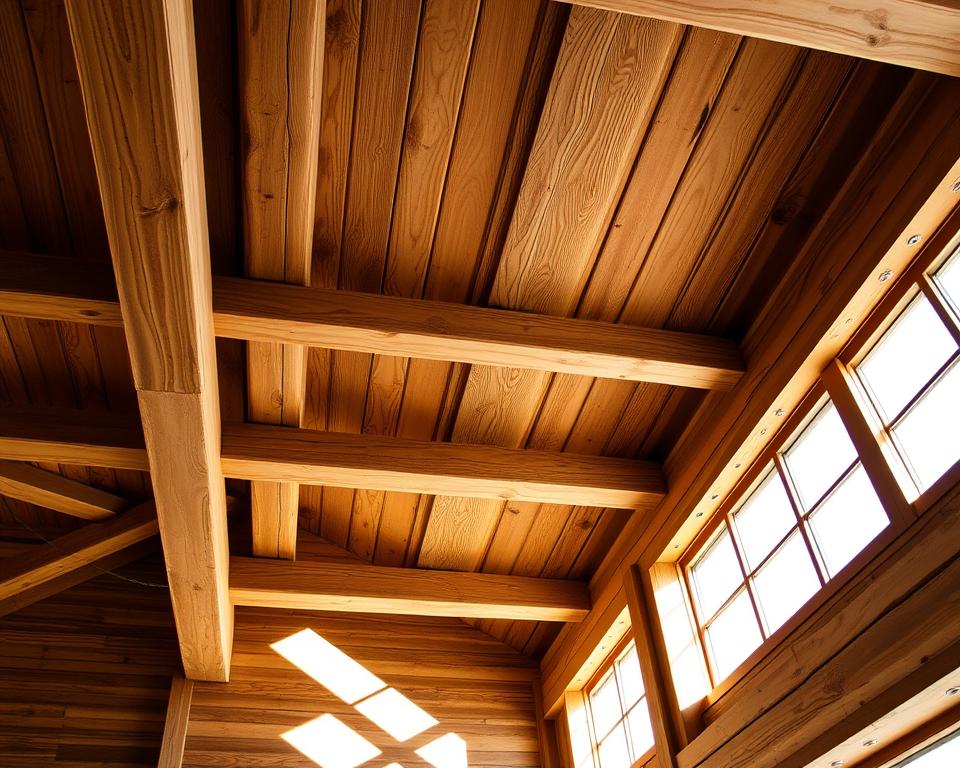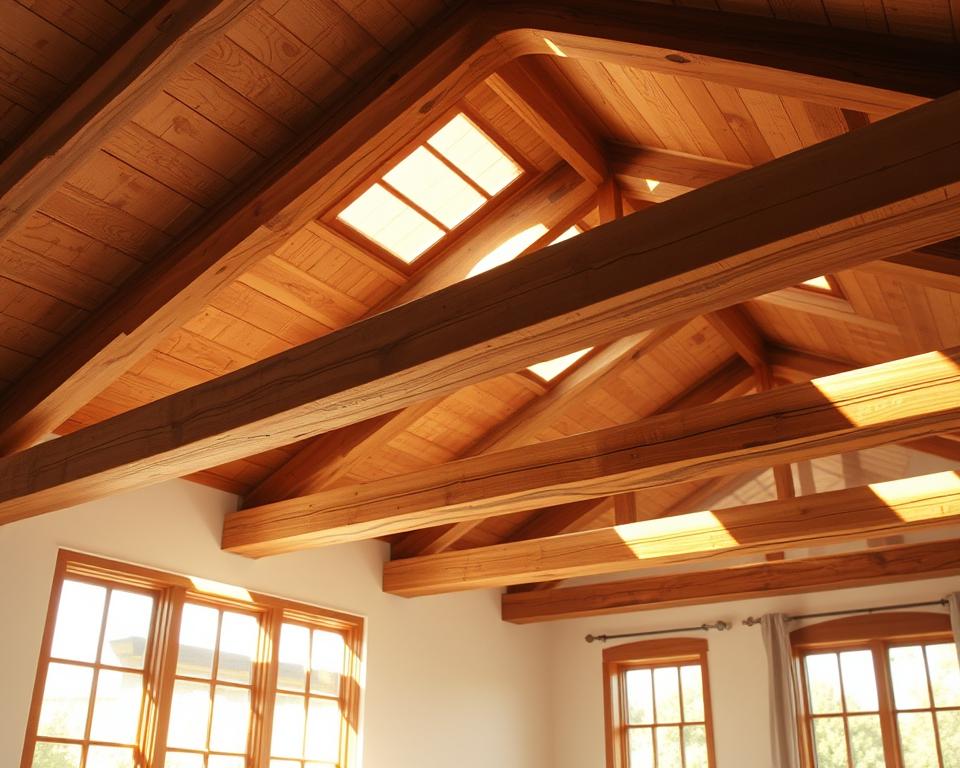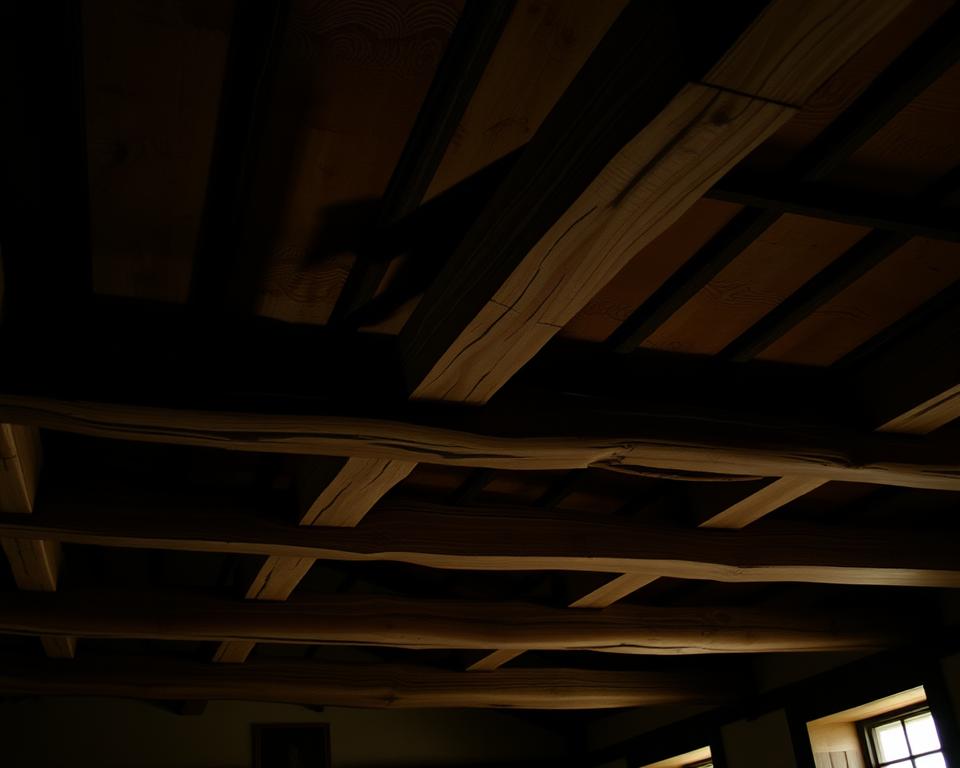Exposed wooden beams are a timeless architectural feature that can elevate any interior design. They add character to traditional, rustic, and farmhouse interiors, and warmth to modern spaces. The use of exposed wooden beams can enhance architectural interest and visual appeal in interior spaces, making them a popular choice for homeowners. Exposed wooden beams, including rustic ceiling beams, can add a sense of history to home interiors, enhancing overall design.
Homeowners can achieve the same look with faux wooden beams, without the high cost and maintenance of real wood. Exposed wooden beams serve as structural supports and were historically left uncovered for economic reasons. This highlights their dual purpose in modern design. In this article, we will explore the benefits and uses of exposed wooden beams in interior design. We will also provide tips on how to incorporate them into your home, including the use of rustic ceiling beams.
Key Takeaways
- Exposed wooden beams can add character and warmth to any interior design
- They can enhance architectural interest and visual appeal in interior spaces
- Faux wooden beams are a cost-effective alternative to real wood
- Exposed wooden beams can be used in various interior styles, including rustic and modern designs
- They can create a sense of history and add depth to a room
- Proper installation and maintenance are crucial to ensure the longevity of exposed wooden beams
- Exposed wooden beams, including rustic ceiling beams, can be used to create a unique and personalized space
What Are Exposed Wooden Beams?
Exposed wooden beams bring depth and character to any room. They often come from reclaimed wood, offering a unique, historic vibe. This design element has ancient roots, serving as structural support in buildings. Now, they’re prized for their beauty, enhancing the look of natural wood ceiling beams.
Reclaimed wood beams infuse a room with warmth and coziness. Their natural texture and color add a tactile quality, making spaces feel more welcoming. They also elevate the room’s sense of height and grandeur, perfect for high ceilings.
Using exposed wooden beams in interior design offers several benefits. They add a historical and character-rich feel to any room. They also bring warmth and coziness, and can make spaces feel more expansive. Natural wood ceiling beams complement these beams, enhancing the room’s overall aesthetic.
In summary, exposed wooden beams are a versatile design element. They add depth, character, and warmth to any space. Whether used for structural support or purely for aesthetic appeal, they’re a favorite among designers and homeowners. This is true, whether made from reclaimed wood or paired with natural wood ceiling beams.
Benefits of Exposed Wooden Beams
Exposed wooden beams bring a rustic charm to any room, making it feel cozier and more inviting. They serve as a structural support, blending functionality with interior design. Choosing reclaimed wood beams is an eco-friendly option, reducing the demand for new wood and waste. These beams, including farmhouse style and rustic ceiling beams, are favored for adding rustic charm.
They can make a room appear taller, enhancing the visual experience from ceiling to floor. High contrast designs between wooden beams and ceilings offer immediate visual impact. Faux wood beams come in various colors, patterns, and textures, offering customization without the expense of real wood.
Aesthetic Appeal
Exposed wooden beams introduce a natural, earthy feel, balancing the aesthetic in interior design. They pair well with earthy hues, enhancing the outdoor vibe of a room. Box beam ceilings add a sense of movement, aligning visually with elements like beds, doors, or tables.
Structural Integrity
Faux beams are not suitable for historic homes, which need solid wood beams to preserve architectural integrity. Yet, they are a cost-effective option for adding rustic charm without the expense and weight of real wood. Faux beams significantly lower renovation costs compared to traditional wood beams.
Eco-Friendly Choice
Using reclaimed wood beams is an eco-friendly choice, reducing the need for new wood and waste. It’s ideal for those wanting to add rustic charm while being environmentally conscious. Popular reclaimed woods include oak, pine, and cedar, used to create unique farmhouse style and rustic ceiling beams.
Popular Interior Styles Featuring Wooden Beams
Exposed wooden beams and natural wood ceiling beams can transform various interior designs. They bring a unique charm to each style. In rustic and farmhouse settings, they add warmth and coziness. In modern minimalism, they contrast with clean lines and minimal decor.
Some popular interior styles that feature wooden beams include:
- Rustic and farmhouse designs, where wooden beams are often left in their natural state to enhance the aesthetic of wooden furniture and mountain-themed decor
- Modern minimalism, where wooden beams can add a touch of warmth and texture to an already sleek and minimalist space
- Industrial chic, where exposed wooden beams can add an edgy and urban feel to a room
Studies show homes with exposed wooden beams have a 25% higher perceived value in the real estate market. Open roof structures with exposed beams can also increase perceived ceiling height by about 15%. This contributes to a more relaxed atmosphere.
Incorporating exposed wooden beams into your interior design offers practical benefits. They can increase natural light perception due to their integration with lighting elements. With proper design and installation, exposed wooden beams can elevate your interior space. They add warmth and character to your home.
Types of Wood Used for Exposed Beams
Choosing the right wood for exposed beams is crucial. The type of wood significantly influences a room’s aesthetic. Reclaimed wood beams offer a unique, historic charm. In contrast, rustic ceiling beams bring warmth and coziness.
Common woods for exposed beams include oak, pine, and cedar. Oak stands out for its durability and versatility, appealing to many homeowners. Pine adds a rustic feel to spaces. Cedar, known for its natural resistance to rot and insects, is also popular.
- Maple: a hardwood known for its light color and fine grain
- Cherry: a hardwood prized for its rich, reddish-brown color
- Hickory: a strong, versatile wood that can add a touch of rustic charm to a room
The choice of wood for exposed beams depends on the desired aesthetic. By selecting the right wood, homeowners can craft a unique, beautiful space that mirrors their style.
Installation Process for Exposed Beams
Installing exposed wooden beams is a detailed process that demands meticulous planning and execution. The cost can fluctuate based on the material type and design complexity. Decorative faux beams cost between $18 to $28 per linear foot. On the other hand, hollowed out real wood decorative beams can range from $28 to $45 per linear foot.
Homeowners have the option to hire a professional or tackle the installation themselves. Preparation and planning are essential for a successful outcome, whether you’re doing it yourself or hiring someone. This involves determining the number and spacing of beams to avoid a cluttered appearance. It also requires selecting the right materials and tools, such as 3-inch wood screws and 2-inch finish nails.
- Using a mounting plate that fastens to the ceiling framing or drywall
- Ensuring proper spacing between beams, such as 3 feet, to achieve a balanced look
- Acclimating real wood beams to the room’s temperature and humidity for 6-7 days prior to installation
By adhering to these guidelines and considering the project’s specific requirements, homeowners can achieve a stunning and practical installation of exposed wooden beams. This is true whether opting for a farmhouse style or another design.
Maintaining Your Exposed Beams
Keeping your natural wood ceiling beams and rustic ceiling beams in top condition is crucial. Regular cleaning, like dusting and vacuuming, helps remove dirt and debris. Seasonal care, such as protecting against extreme temperatures and humidity, also prevents damage. This ensures they remain beautiful and functional.
Here are some essential maintenance tips for your exposed beams:
- Regularly inspect the beams for damage or wear
- Apply a protective coating to prevent moisture damage
- Use wood varnish or oil to extend their lifespan
By adhering to these guidelines, you can effectively care for your natural wood ceiling beams and 
How to Choose the Right Beams for Your Space
Choosing the right beams for your space involves several key considerations. The size and scale of the beams must match the room and furniture, ensuring a balanced look. Exposed wooden beams can bring warmth and character, while reclaimed wood beams offer a sustainable and unique option.
The color and finish of the beams should enhance the room’s decor. Consider your home’s style and era, along with your personal taste. For instance, a rustic home might suit reclaimed wood beams, while a modern home might prefer sleeker designs.
Popular ceiling beam options include:
- Solid wood beams, known for their traditional look but can be heavy and pricey
- Polyurethane beams, lighter and more affordable but less authentic than solid wood
- Box beams, hollow and lightweight, yet can be custom-made to mimic solid beams
The ideal beams for your space depend on your specific needs and preferences. By evaluating size, scale, color, and finish, you can select beams that elevate your interior’s aesthetic and dimension.
Mixing Exposed Beams with Other Design Elements
Mixing exposed beams with other design elements can create a unique and cohesive look. Exposed wooden beams, like those with a farmhouse style, offer versatility. They can be paired with pendant lights or chandeliers to add elegance to a room.
When combining exposed beams with other design elements, consider the aesthetic you aim for. For instance, pairing beams with wall colors can enhance the room’s look. Farmhouse style beams work well with earthy tones for a cozy feel. On the other hand, natural wood ceiling beams complement brighter colors for a modern vibe.
- Integrating beams with lighting fixtures, such as pendant lights or chandeliers
- Complementing beams with wall colors, such as neutral or bold colors
- Pairing beams with other natural materials, such as stone or plants
Mixing exposed beams with other design elements can create a unique and cohesive look. Whether aiming for a modern or traditional style, natural wood ceiling beams and farmhouse style beams are excellent additions.
Common Mistakes When Installing Wooden Beams
Installing exposed wooden beams can be tricky. One major error is overcrowding a space, leading to a cluttered and overwhelming feel. Another mistake is not considering the ceiling height, resulting in beams that are either too low or too high.
To sidestep these pitfalls, it’s crucial to think about the beams’ size and the room’s scale. Ensuring there’s enough space between beams can make a room feel more open and airy. For more insights, check out hiding electrical beams to understand the process and common mistakes to steer clear of.
Common errors to watch out for include:
* Overcrowding a space
* Ignoring the ceiling height
* Not considering the size and scale of the beams and the room
* Not leaving enough space between beams
Avoiding these mistakes can help you create a stunning and practical space. Remember to plan meticulously, think about the beams’ and room’s dimensions, and ensure there’s ample space between beams. This will help achieve a light and airy atmosphere.
Budgeting for Exposed Wooden Beams
Integrating exposed wooden beams into your interior design requires careful budgeting. The cost can vary significantly, influenced by material type, size, and design complexity. Natural wood ceiling beams and reclaimed wood beams are favored, yet they come with a higher price tag.
Several factors contribute to the overall cost:
- Material costs: The wood type, such as oak or pine, impacts the price.
- Size and complexity: Larger, more intricate designs demand more material and labor, raising costs.
- Installation costs: Professional installation adds to the total expense.
Yet, there are more affordable options. For instance, faux beams crafted from composite materials can cost about $18 per linear foot. This alternative offers a cost-effective way to mimic the look of reclaimed wood beams or natural wood ceiling beams.
Here’s a rough breakdown of costs:
| Material | Cost per linear foot |
|---|---|
| Reclaimed wood beams | $20-$50 |
| Natural wood ceiling beams | $30-$70 |
| Decorative faux beams | $18 |
Exposed Wooden Beams: A Farmhouse Style Staple
Exposed wooden beams are a cornerstone of farmhouse style, adding a rustic charm that is both timeless and inviting. These beams, often reclaimed from old barns or salvaged from other structures, bring a sense of history and authenticity to any space. Their natural beauty and weathered appearance make them a perfect fit for those who appreciate the rustic farmhouse look.
One of the key benefits of exposed wooden beams is their ability to create a sense of openness and grandeur. Whether used in a living room, dining room, or even a bedroom, these beams can instantly elevate the aesthetic of a space. Their presence can make a room feel larger and more spacious, while also adding a touch of elegance and sophistication.
When it comes to incorporating exposed wooden beams into your home, there are several options to consider. You can opt for beams that are left in their natural state, showcasing their unique character and imperfections. This approach adds a raw, rustic charm that is quintessential to the farmhouse style.
Another option is to stain or paint the beams to enhance their appearance. This allows you to choose a color that complements the overall design of your space, whether it’s a warm, earthy tone or a bold, contrasting hue. Staining or painting can also help to highlight the grain and texture of the wood, adding depth and visual interest to the beams.
Regardless of whether you choose to leave the beams natural or enhance them with stain or paint, they will undoubtedly add a touch of farmhouse style to your home. Exposed wooden beams create a cozy and inviting atmosphere, making them perfect for creating a warm and welcoming living space.
So, if you’re looking to incorporate the rustic farmhouse look into your home, consider adding exposed wooden beams to your design. Their natural beauty, weathered appearance, and ability to create a sense of openness and grandeur make them a timeless and versatile element that can enhance any space.
Benefits of Exposed Wooden Beams:
- Add a rustic charm and authenticity to your space
- Create a sense of openness and grandeur
- Enhance the aesthetic of any room
- Make a room feel larger and more spacious
- Add a touch of elegance and sophistication
FAQ
What are exposed wooden beams?
What are the benefits of exposed wooden beams?
What interior design styles can feature exposed wooden beams?
What types of wood are commonly used for exposed beams?
What is the installation process for exposed wooden beams?
How do you maintain exposed wooden beams?
What factors should be considered when choosing the right beams for a space?
What are some common mistakes to avoid when installing wooden beams?
How can you budget for exposed wooden beams?

Leonardo Freitas is a writer at TrendGaping, specializing in farmhouse-style interiors and sustainable wood decor. He delves into the art of blending rustic elements with modern minimalism, offering tips on how to create cozy, elegant spaces. Through his content, he aims to help readers transform their homes into serene, nature-inspired retreats.


